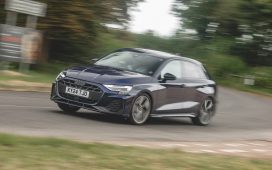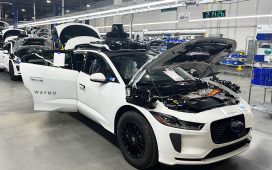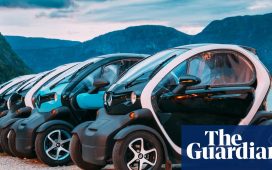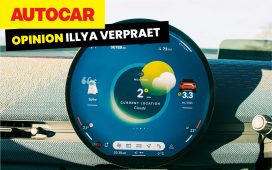To see if you can really do a proper road trip in an electric car, I jumped in a Jaguar I-PACE on a UK adventure from Edinburgh via Oban down to the home of Jaguar in Coventry. This is what I discovered…
Despite what some might say, electric cars haven’t “ruined the weekend”. It’s becoming increasingly easy to make the switch to electric in Australia, with the price of electric vehicles starting to become more competitive, the quality of EVs only improving and charging networks continuing to grow around the country.
Yet range anxiety still looms large in the mind of many motorists – and even some seasoned EV drivers are reluctant to take their cars out for long road trips. The reality is that Australia’s vast distances, combined with a still reasonably sparse charging network, pose real challenges for car manufacturers trying to push battery juice.
In comparison, the UK has some of the best EV charging infrastructure in the world, and far shorter average driving distances than you’d encounter in Australia. It’s a glimpse of the future for us eco-minded Aussies.
That’s why when I had the chance to take an electric car (and a very nice electric car at that) for a proper drive down through The Mother Country, I was very keen to see how I’d go, and compare it to my experiences of electric motoring in Australia. Here’s what I discovered.
In this electric road trip article…
The Route

Starting off in the centre of Edinburgh, we headed west towards Oban, a picturesque resort town on Scotland’s west coast that’s known as “the Gateway to the Isles”; it’s where you’d get on a ferry to Islay, for example.
We then planned a magnificent drive loop up to Glencoe before heading down south to England. The roads around that part of the Scottish Highlands are some of the most beautiful and fun to drive in Europe; it’s truly stunning.
Then, we drove down the bonnie, bonnie banks of Loch Lomond on a big southern thrust towards the picturesque Lakes District, where we spent a night in Keswick. We then jumped back on the road to smash down to Stratford-upon-Avon, where we spent another night, and then returned the car to Jaguar at Jaguar Land Rover’s headquarters in Gaydon.
All in all, we drove well over 1,000kms in just over 3 days. A comparatively small distance by Australian standards, but still a fairly substantial trip.
The Car
The Jaguar I-PACE is the British brand’s first-ever ground-up electric car, and it’s a pearler. Jaguar was one of the first luxury car brands to realise the importance of electric cars, and five years on from its introduction, the I-PACE remains an exemplar in its field.

A lithe compact crossover, it’s got that perfect mix of sportiness and luxury the Jaguar brand is known for. It can comfortably fit five adults, but it’s also a pretty nippy little thing. It’s got a dual-motor, all-wheel drive setup that’s good for 295kW/700Nm of torque (that’s a lot of torque) and it’ll do 0-100km/h in 4.8 seconds. It’s got a WLTP-rated range of 470km, although we found in real-world driving conditions, it was more like 330kms of range. Not too terrible.
I have to admit, I’d never been the biggest fan of Jaguar before driving the I-PACE, but it seriously changed my impression of the brand. Simply put, the I-PACE’s interior is one of the nicest and easy-to-use car interiors I’ve ever come across. Acres of supple leather and one of the best centre console layouts in the business – it’s a very nice place to be, especially for a long road trip.
RELATED: The Longest Range Electric Cars Available In Australia
It also drives extremely well. Not only does it have plenty of grunt (great for merging off British motorway roundabouts), but it handles extremely well, especially for a car of its size and weight (with a kerb weight of 2,133 kg, it’s not exactly an E-Type).
One of the I-PACE’s coolest features is how you can raise and lower the suspension on demand with a push of a button. This is great for when the roads get a little rougher or if you need to clear a nasty driveway. It’s also fun to feel the car go up and down. Yes, I’m a child.
All in all, it was a pretty amazing road trip companion. My only real complaint was that its normally fairly generous 656L boot was mostly taken up by the spare wheel Jaguar provided us with for the trip (the I-PACE normally just comes with a tyre repair kit). For a long road trip, a full-size spare is essential, so the fact it compromised so much boot space was a slightly unpleasant surprise. That’s a nitpick though.

What We Learnt On The Trip
Our road trip from Edinburgh to Gaydon was an absolute delight. Much of that was thanks to the Jaguar, which was a truly exemplary car. The scenery was unbelievably beautiful, and the roads, almost without exception, were like butter. The driving roads from Edinburgh to Oban as well as the loop around Glencoe were easily some of the best roads I’ve ever had the chance to tackle, too.
But the road trip was also a real eye-opener to the realities of electric car ownership – as well as the difference (or lack thereof, as we found out) between driving an electric car in the UK versus Australia.
Owning an electric car in the UK is much more ‘normal’
It was pretty surprising to see how many EVs were on the road in the UK. They’re everywhere, and they’re hard to miss, thanks to their green license plates.
Partly this is because they’re comparatively a fair bit cheaper to buy in the UK than they are in Australia. There’s also a far larger range of EVs out and about, including models from European marques which haven’t been brought Down Under, such as the Renault Megane E-Tech or Volkswagen ID.3.
The charging network is also much bigger in the UK. Britain has roughly 10 times the number of public charging stations as Australia, despite the fact that Australia is about 32 times bigger than the UK.
RELATED: The Next Battle Ground For Australian EV Owners? Home Charging Stations
While Australia’s East Coast is reasonably well-served with charging stations in 2023, it’s just so much easier to drive long distances electrically in the UK. It wasn’t a daunting prospect driving 1,000kms – Australia’s a different story.
British drivers still aren’t used to electric cars
Despite being so much more common on British roads than they are in Australia, British drivers still haven’t wrapped their heads around EVs – in a good way. You constantly get underestimated in an electric car; drivers just don’t expect you to be fast.
Then, when you speed away from them when the traffic lights go green, barely making a sound, you leave them totally flabbergasted. It never gets old. Being able to chop 99% of drivers at the lights, to me, is one of the major selling points of any EV.

Having that instant torque and acceleration on demand is also a useful tool when trying to navigate Britain’s motorways, especially in the wet (and it’s Britain, it’s usually wet). Poms tend to be, on average, better drivers than Aussies… But they’re much ruder and have far less patience. So much for a stiff upper lip.
You still need to plan out your trip
The UK (and Scotland in particular) might have a much denser charging network than Australia, but you still can’t just jump in your electric car and hope to wing it.
Apps like ZapMap and PlugShare help take a lot of the guesswork out of it – as does good ol’ Google Maps, truth be told – but you can’t necessarily rely on the apps, as we found out.
RELATED: I Committed A Cardinal Road Trip Sin & Have Absolutely Zero Regrets
The Jaguar I-PACE’s infotainment system also lets you know where nearby charging stations are, making it much easier to plan your route. It’ll even alert you if you plan a route that will require charging along the way.
Charging can be surprisingly complicated
Just knowing where chargers are is only half the battle. There were a few times during the trip when we made our way to a charger only to find we couldn’t use it for some reason.
Case in point: Oban. We initially chose to spend a night in Oban because there were at least four different charging locations in the small town. Initially, we thought that was rather impressive – until we actually got there.
The first charger we arrived at, the one closest to our hotel, was part of a charging network that you could only access if you were Scottish. Our foreign phones couldn’t download the app you needed to use to charge it, pay by phone wasn’t working, and the website kept crashing.

The second charger, which was listed on PlugShare as being publically available, was actually inside a private carpark which we couldn’t access after hours. The third charger was straight-up broken. Thankfully, there was a charger in the local Tesco’s carpark, so we charged the car overnight there… Only to find when I got back to Australia that we’d got a parking ticket. There were no signs to indicate that it was restricted parking.
Glasgow, despite being a major city, is bizarrely underserviced by charging locations, although we were able to find a fast charger in a service area just outside of town. When we arrived in Keswick, one of the two chargers in town was in use, meaning we had to go to the other side of town to use the other one.
So yes, whilst it’s easier to do an electric road trip in the UK compared to Australia (and many other countries), it’s still not perfect.
It wasn’t all bad news, however. To our delight, we found that the hotel we stayed at in Stratford-upon-Avon had multiple free wall chargers, so we could top up before heading to Gaydon. Imagine being able to fill up an ICE for free! Not a chance. On that…
We saved a lot of money
I always thought Australian petrol prices were pretty steep but British petrol prices are daylight robbery. While public charging stations still cost something, filling up our car with petrol as opposed to volts would have been a very expensive exercise.
RELATED: American RV Owner’s Petrol Pumping Video Shows Insane Cost Of Road Tripping Right Now
For pure comfort, electric is the way to go
On long drives, it’s easy to get fatigued, even as a passenger. This is where EVs come into their own: because they’re so smooth and so quiet, they’re great on long hauls. Admittedly the Jaguar I-PACE is a particularly luxe electric car, but this is true for all EVs.

The Verdict
Despite a few teething issues with charging, I found my 1,000km British battery-powered road trip to be pretty bloody easy. Sure, maybe you can’t tear through an entire country in the same way you might be able to in a petrol-powered car, but have you ever heard of “stop, revive, survive”?
The reality is that you need to take regular breaks whilst driving long distances anyway, so factoring in having to charge your electric car really isn’t a big deal. There was no point during the trip where we really had to wait on the car to finish charging: either we were able to charge it overnight, or we were able to have it charge while we had something to eat and so on.
I’d definitely do it again – especially if I could do it again in an I-PACE. Again, I was really taken aback by our plucky Jag: refined, fun and easy to use, it’s a very complete package. Do it again in Australia? Now that’s another story… Although I’m more confident about the prospect now than before I did 1,000kms across the UK.
Yes, going on an electric road trip requires a bit of planning and a bit of a mindset shift. But if you can get past the idea of chewing up dead dinosaurs and embrace the joys of a silent electric zoom, you’ll have a great time.
Find out more about the Jaguar I-PACE at Jaguar’s online showroom here.










